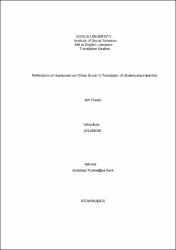| dc.contributor.author | İçöz, Nihan | |
| dc.date | 2015 | |
| dc.date.accessioned | 2015-02-18T15:15:16Z | |
| dc.date.available | 2015-02-18T15:15:16Z | |
| dc.date.issued | 2015 | |
| dc.identifier.uri | https://hdl.handle.net/20.500.11857/410 | |
| dc.description.abstract | Until the second half of the twentieth century, translation has been regarded as a simple linguistic performance which results from substitution of words in the source text with their equivalences in the target text. For this reason, it has been studied as a part of certain social sciences like linguistics and literature. The increasing studies and practice in the field proved that translation activity was a more complex phenomenon which involved participation of other disciplines. As a result, in 1980s, translation became an independent field of study as “translation studies”, building its own models and theories. With the emergence of the recent theories, new concepts came to the fore. Traditional terms like “source-text orientation”, “fidelity to the source text”, “equivalence”, “fixed meaning” and so on were replaced by more functional terms like “aim of translation”, “cultural formation”, “target-text orientation” and “interpretation”. The Turkish Republic, younger than the developments in translation studies, had already put those improvements into practice in its acculturation period. The aim of the study is, firstly to have a broader look into the cultural formation of the Republican Era and present how translation gets involved in this cultural formation period and secondly to present it with a specific translation practice during the period. | |
| dc.description.abstract | Yirminci yüzyılın ikinci yarısına kadar çeviri, kaynak metindeki ifadelerin erek metindeki karşılıklarının bulunmasından ibaret olan basit bir dilsel edim olarak görülmüştür. Bu sebeple de, dilbilim ve edebiyat gibi bazı sosyal bilim dallarının bir bölümü olarak incelenmiştir. Alana dair artan çalışma ve uygulamaların, çeviri etkinliğinin diğer disiplinlerin işbirliğini de gerektiren, daha karmaşık bir olay olduğunun kanıtlanmasıyla çeviri 1980lerde “çeviribilim” adıyla, kendi model ve teorilerini kendisi üreten bağımsız bir bilim haline gelmiştir. Yeni teorilerin ortaya çıkmasıyla yeni kavramlar da ortaya çıkmış, “kaynak metin odaklılık”, “kaynak metne sadakat”, “eşdeğerlik”, “tek ve değişmez anlam” gibi geleneksel kavramlar yerini, “çevirinin amacı”, “kültürel yapılanma”, “erek metin odaklılık” ve “yorum” gibi daha işlevsel ve güncel terimlere bırakmıştır. Çeviribilimdeki bu gelişmelerden daha genç olan Türkiye Cumhuriyeti bu yenilikleri kendi kültürlenmesinde zaten hayata geçirmiştir. Bu çalışmanın amacı, Cumhuriyet Dönemi’ndeki kültür yapılanmasına daha geniş bir açıdan bakmak ve onu aynı döneme ait bir çeviri uygulamasıyla örneklendirmekt | |
| dc.language.iso | eng | |
| dc.rights | info:eu-repo/semantics/embargoedAccess | |
| dc.subject | Translation | |
| dc.subject | Humanism | |
| dc.subject | Culture | |
| dc.title | Reflections of Humanism on Orhan Burian's Translation of Shakespeare's Hamlet | |
| dc.title.alternative | Hümanismin Orhan Burian'ın Shakespeare'nin Hamlet Çevirisine Yansıması | |
| dc.type | masterThesis | |
| dc.department | [KLÜ] | |
| dc.relation.publicationcategory | Tez | |



















